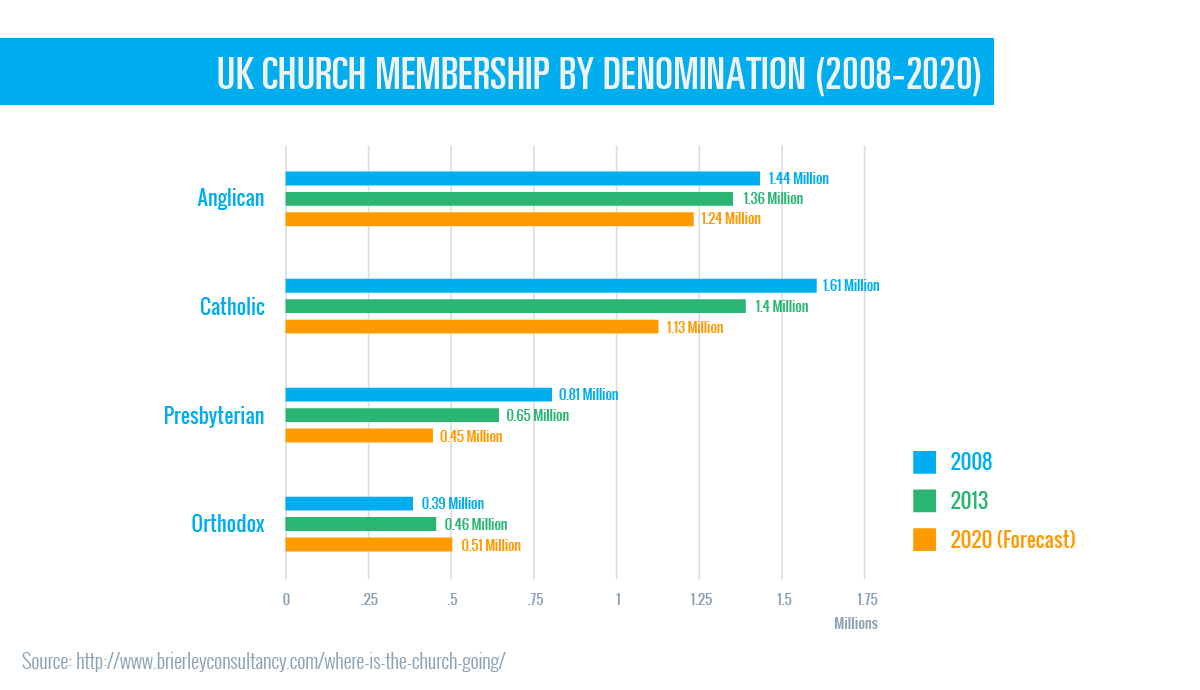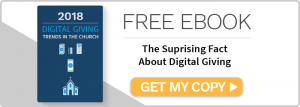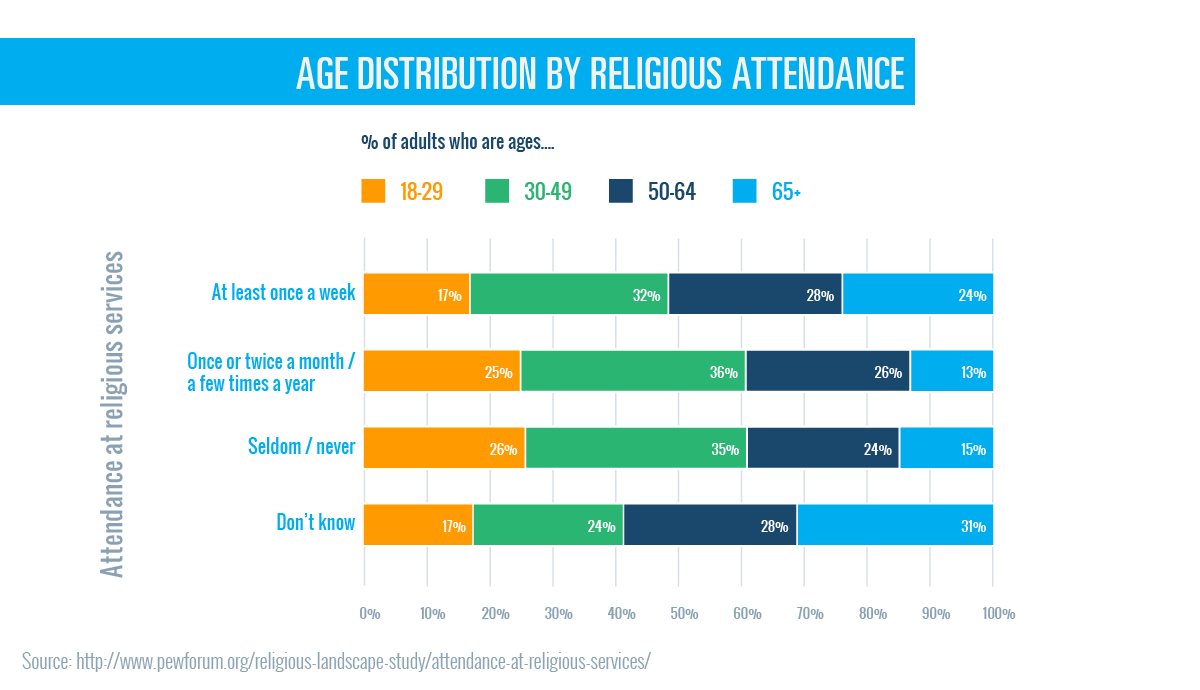The Ultimate Guide to Understanding and Growing Church Attendance
Updated August 11, 2023 |
For decades, attendance has continued to be one of the most important metrics for churches to track, as it helps to discern the health of a congregation, and whether or not it’s growing. But two major details have shifted in the past few years: 1) reports continue to come out that fewer people are attending church, and 2) digital technologies have changed how we track and manage church attendance.
All of these changes can make any church wonder if they’re still approaching attendance with the right intentions and tactics.
In this guide, we’ll be taking a look at the following:
- Important church attendance statistics and what they tell us
- Practical ways to measure attendance at your church
- A few ways to fill your church building every day
6 Important Church Attendance Statistics and What They Tell Us
There’s been a lot of discussion around the steady decline in church attendance and the big drop in church visitors. And many people leading these conversations say that Millennials are leaving the church in droves. But is it true? Is the problem as bad as we’re led to believe?
A lot of blogs and online articles use faulty statistics or fail to cite their sources for the data they provide. When an article is built upon statistical data, we need to check those sources and make sure they’re legitimate.
Statisticians and polling services like Gallup, the Pew Forum, and the Barna Group have been bringing us legitimately-sourced information for decades. When it comes to statistics, we can trust that we’re getting the most reliable information possible from organizations like these.
We went to these sources to get some answers about the state of church attendance in the United States—and we came away with a helpful understanding of many Americans’ worshiping habits.
Here are six interesting discoveries we made while researching 21st-century church attendance.
1. The rise of the “Nones”
Thanks to Gallup surveys dating all the way back to 1948, we’re able to uncover significant trends in the way Americans have identified themselves religiously over the last 68 years (information only exists through 2016).
In 1948, 22 percent of Americans identified as Catholic. In the early 80s, that percentage climbed to 29 percent—the highest point in this 68-year window. By 2016, the percentage was back down to 22 percent.
Four percent of Americans identified as Jewish in 1948, and, like those who identified themselves as Catholic, the number hasn’t fluctuated much. The number dropped to three percent by 2016.
But this stability disappears when we start looking at Protestants. In 1948, most Americans (68 percent) identified themselves as Protestants. This number reached its apex in 1954 and 1956 at a startling 71 percent. We then see a pretty steady decline until we hit 37 percent in 2016—an overall drop of 31 percent.
WHAT’S HAPPENED TO THE PROTESTANTS?
So where are these Protestants going? We know that they’re not converting to Catholicism, Judaism, or Mormonism because there’s hardly been any fluctuation there. In 1999, Gallup started tracking denominationally nonspecific Christian affiliation. That’s grown from two percent to 10 percent in 2016, so that might account for some Christians who have jumped from the Protestant camp to a more nondescript Christian identity.
But next to the drop in Protestantism, the most dramatic change is in those who don’t identify as religious at all. (In recent years, sociologists have begun calling this group “the Nones.”) In 1948, only two percent of Americans considered themselves to be nonreligious. Although that number steadily grows over the years, it doesn’t hit double digits until 2002 (that’s only an increase of seven percent in 54 years)—but between 2002 and 2016 it jumps from 10 to 18 percent.
In 14 years, the number of nonreligious people in the US had grown more than in the previous half-century.
WHAT DO THESE STATISTICS TELL US?
We see a couple of significant things happening here. Many of the Americans that would have identified as Protestants before the 1970s have died, but they haven’t been entirely successful at passing their faith on to their children. A lot of these children have disassociated themselves from the Protestantism of their youth. We’re also starting to witness adults who would have previously identified as Protestant transitioning into Nones themselves.
We’ve already seen these trends occurring across Europe. Looking at faith research from 1983–2015 from a British Social Attitudes Survey, the Church of England has dropped by nearly half (16.5 million to 8.6 million). The number of non-Christian religions have increased five-fold (.8 million to 4 million), and the “Nones” have nearly doubled (12.8 million to 24.7 million).

The American church has its work cut out if it wants to stop the attrition. We need to take an honest look at why the next generations are not identifying with the gospel message and prayerfully consider ways we can meet them where they are.
2. The decline in church membership
Another question Gallup has been tracking since 1992 is “Do you happen to be a member of a church or synagogue?” In 1992, 70 percent of Americans claimed to be regular attendees of a house of worship. Less than 25 years later, that number has dropped to 55 percent.
When you look at the other religious affiliation numbers for the same time period, it’s pretty interesting. If you add up all of the Americans that identified a religious affiliation in 1992, about 90 percent claimed to be Protestant, Christian, Catholic, Jewish, Mormon, or other, while 70 percent of Americans claimed to regularly attend a church or synagogue.
That leaves about 20 percent of Americans in 1992 who identified as religious but were not members of any place of worship.
In 2016, 79 percent of Americans claimed to have some religious affiliation, but only 55 percent were members of a church or synagogue—a difference of 24 percent. So between 1992 and 2016, the number of people who considered religion important to them, but didn’t attend a church regularly, had only risen four percentage points.
WHAT DO THESE STATISTICS TELL US?
There’s definitely a drop in people who would consider themselves members of a church or a synagogue. In just 24 years, there’s been a 15 percent drop in regular church attendance—but there is a silver lining.
Even with the drop in religious affiliation, there hasn’t been a dramatic change in the percentage of devoted people who find it important to be part of a religious community. In 1992, 20 percent of Americans identified themselves as religious but didn’t have a church home. And even though there’s been a significant drop in people who consider themselves religious, roughly the same percentage of those believers do not place a premium on having a church or synagogue where they belong—20 percent vs. 24 percent.
There will always be people who are inclined toward religious belief but don’t see any importance in belonging to a community of faith. It’s good news that this number isn’t growing dramatically. It probably isn’t necessary (or helpful) to continue to pick on the people who don’t see regular church attendance as important to them. The problem here isn’t really an intellectual one; it’s a spiritual one.
Instead, the church should continue to focus on reaching those who have not yet made a religious commitment. To learn more about this and other key stats your church should know about, download a free copy of the 2018 Digital Giving Trends in The Church ebook today!

3. Church attendance by age
A Pew Forum report on attendance at religious services looked at church attendance by age group. The responses broke down like this:
- Ages 65+
- At least once a week: 24%
- Once or twice a month/a few times a year: 13%
- Seldom/never: 15%
- Don’t know: 31%
- Ages 50–64
- At least once a week: 28%
- Once or twice a month/a few times a year: 26%
- Seldom/never: 24%
- Don’t know: 28%
- Ages 30–49
- At least once a week: 32%
- Once or twice a month/a few times a year: 36%
- Seldom/never: 35%
- Don’t know: 24%
- Ages 18–29
- At least once a week: 17%
- Once or twice a month/a few times a year: 25%
- Seldom/never: 26%
- Don’t know: 17%

What do these statistics tell us?
It’s interesting to note the demographic born between 1968–1987 is the one you’re most likely to find in church on a Sunday morning. That’s followed in succession by the 50–64 and the 65+ groups.
We see a significant drop off in the group born between 1988–1999. They’re almost half as likely to attend church every week, and only one out of four of them attend occasionally (the same as the number that never attends). It’s no wonder that there are so many discussions and blog posts exploring the reasons Millennials are leaving the church. It’s the most pressing issue for the American church in the 21st century.
The church isn’t going to reach this generation by attempting to speak their language or become better at entertaining them. That might have worked with Generation X because they had inherited so many of their values from the previous generations.
The world that Boomers and Gen Xers grew up in had more similarities than differences. Millennials have grown up in a tech world that bears little resemblance to previous generations. We need to examine the ways that this generation sees the world differently—and then find areas where we can identify with them and demonstrate how the gospel is aligned with them.
4. Why people attend their churches
In March 2017, Gallup presented survey takers with a number of things that might convince them to attend a particular church. Then they asked them to rate them as major factors, minor factors, or not a factor. (They could also choose “no opinion,” which remained one percent throughout.)
Here’s how survey takers responded:
- Sermons or talks that teach you more about scripture:
- Major factor: 76%
- Minor factor: 16%
- Not a factor: 8%
- Sermons or lectures that help you connect religion to your own life:
- Major factor: 75%
- Minor factor: 16%
- Not a factor: 8%
- Spiritual programs geared toward children and teenagers:
- Major factor: 64%
- Minor factor: 21%
- Not a factor: 15%
- Lots of community outreach and volunteer opportunities:
- Major factor: 59%
- Minor factor: 27%
- Not a factor: 13%
- Dynamic religious leaders who are interesting and inspiring :
- Major factor: 54%
- Minor factor: 28%
- Not a factor: 17%
- Social activities that allow you to get to know people in your community:
- Major factor: 49%
- Minor factor: 36%
- Not a factor: 14%
- A good choir, praise band, cantors or other spiritual music:
- Major factor: 49%
- Minor factor: 36%
- Not a factor: 14%
What do these statistics tell us?
There are a lot of areas where churches can focus their energy and attention. For the most part, they’re making these decisions based on what they see in churches around them or discern as important from Christian radio, magazines, books, and the blogosphere. It’s eye-opening to discover what people are actually looking for.
As is to be expected, sermons and homilies are at the top. People want to learn more about scripture, and they want to learn how their religious beliefs intersect with their personal lives. Next comes spiritual programs aimed at younger people. This area isn’t really a surprise, either. A lot of families end up at church because they want to expose their children to a Christian education.
What’s amazing is where worship music fell in this section. The Christian worship industry is fairly large and exerts a lot of influence. It would be easy to think that a good worship band or program would be a huge factor in convincing someone to commit to a church. Not only does music have the lowest percentage of people who consider it a major factor (38 percent), but one in four people say it’s not a factor at all (25 percent).
Above music, people valued opportunities to volunteer and take part in community outreach. They also wanted more social activities that would help them connect to the people in their communities. Churches would find it interesting to see how their time and budget was spent compared to these answers.
5. Reasons for not attending a church
Gallup then asked the group that seldom/never attended church to rate a selection of reasons why. These survey takers were asked to rate the reasons with major reason, minor reason, or not a reason.
Here’s how they responded:
- You prefer to worship on your own:
- Major reason: 44%
- Minor reason: 21%
- Not a reason: 34%
- You don’t like organized religion:
- Major reason: 36%
- Minor reason: 25%
- Not a reason: 37%
- You aren’t very religious:
- Major reason: 33%
- Minor reason: 32%
- Not a reason: 33%
- You haven’t found a church or other place of worship that you like:
- Major reason: 33%
- Minor reason: 32%
- Not a reason: 33%
- You don’t have the time:
- Major reason: 19%
- Minor reason: 28%
- Not a reason: 52%
- You aren’t sure what religion is right for you:
- Major reason: 17%
- Minor reason: 23%
- Not a reason: 59%
- You don’t like being asked for money when you attend:
- Major reason: 16%
- Minor reason: 29%
- Not a reason: 55%
- Poor health or other problems prevent you from going:
- Major reason: 16%
- Minor reason: 29%
- Not a reason: 55%
- You don’t feel welcome when you do attend:
- Major reason: 16%
- Minor reason: 29%
- Not a reason: 55%
What do these statistics tell us?
First of all, we can be thankful that “I don’t feel welcome when I attend” was the least significant reason. 65 percent said it wasn’t a factor and only nine percent considered it a major reason they don’t attend a church. The number of unfriendly houses of worship in the United States is small. Churches are generally excited to welcome visitors.
Unfortunately, it would be easier for a church to work on being more welcoming than it would to overcome the biggest reason people avoid church: “I prefer to worship on my own.”
Churches need to get better at communicating why belonging to a community of faith is better than worshiping alone, and then they have to prove it to be true in their own communities. It’s one thing to say that community is better than religious isolation, but it needs to be demonstrated. As Jesus says, “By this all people will know that you are my disciples, if you have love for one another” (John 13:35).
Next, churches need to operate within their communities in a way that makes them thankful the churches exist. In order to address people’s distaste for organized religion (the second reason people avoided church), we need to do it by serving our communities in a way that makes them thankful we exist. If people perceive that the church exists simply to get them to attend, behave, and contribute, they’re going to continue to be skeptical of organized religion.
The only way people will overcome this skepticism is by experiencing churches that are serving, loving, and giving back to their communities.
6. Most Americans attend small-to-medium-sized churches
In their 2016 State of the Church report, the Barna Group looked at church size. They found that 46 percent of Americans attend churches with 100 or fewer members. Another 37 percent attend churches with more than 100 members, but fewer than 500. That means that 83 percent of the people who attend church go to churches with fewer than 499 members—with the lion’s share worshipping in churches of 100 or fewer.
As for larger churches, nine percent of Americans attend churches with 500 to 999 attendees, while eight percent attend churches of 1,000 or more.
What do these statistics tell us?
While most Christian marketing and media attention focuses on the American megachurch, this isn’t the standard by a long shot. Pastors are all too easily lured into believing the myth that a healthy church is the same as a big church.
It’s amazing how many pastors know that the average church size is less than 100 people, but still feel like failures for leading smaller churches. Maybe it’s time for the church to acknowledge and recognize the importance of the megachurch movement while celebrating the significant value that smaller, normal churches bring to the Kingdom.
Becoming Students of the Trends
The more attention the church pays to these kinds of statistics, the better prepared we are to identify changes and respond to new challenges and opportunities. Watching these trends can equip us to ask the right questions and adapt to changes in our culture!
To discover the other key statistics affecting the church, click here to download the free ebook, Digital Giving Trends in The Church today!
5 Ways to Measure Church Attendance
Church attendance is one of the most important metrics to pay attention to. But how do you get an accurate headcount without making it weird? You don’t want anyone to feel like they’re just a number, but you also want reliable data so you can see trends in church growth.
Here are five ways to measure church attendance:
1. COUNT THE NUMBER OF CARS
Counting cars is a simple way to get a decent estimate of how many people show up on Sunday. This is especially easy if you have volunteers directing traffic in the parking lot.
According to the Bureau of Transportation Statistics, recreational trips in the US (such as a drive to church) average 2.1 people per vehicle. After everyone shows up, count the number of cars in your parking lot and multiply it by 2.1.
2. USE A TALLY COUNTER
You may remember these from your days of riding the school bus as a kid, but tally counters are an affordable way to count the number of people at your church without worrying about losing track. A mechanical tally counter is cheap, but an app is more discreet. Ideally, you’d use this in a way that people don’t notice (like with a greeter in the parking lot), so nobody feels like a number.
Keep in mind, tallying the number of attendees isn’t the only way to measure attendance, nor is it the only thing worth measuring at your church. As you brainstorm creative ways to keep track of growth and change at your church, discover what more you can be doing by downloading the free ebook, 5 Crucial Church metrics You’re Not Measuring, today.
3. MAKE A SEAT MAP
Creating a map of the seats in your sanctuary lets you send someone to mark which seats are empty or full instead of counting people. Then you can count the empty seats later. Assuming you have fewer empty seats than people, this saves you a lot of counting. Plus, to anyone watching, it looks like you’re finding open seats for anyone who comes in late. (Which is a good thing for a growing church to do, anyway!)
4. GET AUTOMATED PEOPLE COUNTERS
Automated counters use cameras to measure foot traffic in strategic locations. If you set one of these up at the main entrance to your building or the door to your sanctuary, you don’t have to have anyone physically count people, and you’ll probably wind up with more reliable data.
Some of these systems are pretty discreet, so depending on where you put it, people may not even notice it’s there.
5. GIVE EVERY PERSON A BULLETIN
If you print off 200 bulletins and hand out 127, it’s pretty safe to say you had at least 127 people in your service. Keep track of how many bulletins you print each weekend, then at the end of the service count how many you have left and subtract that from the number you printed. That’ll give you the number of people who attended. Not every person will take a bulletin, but you can always set one aside for every person who says they don’t want one. That way, you’ll still wind up with an accurate count.
BE ENCOURAGED
Attendance can be a pain to deal with in a growing church. When your church was small, it was easy to do a quick, inconspicuous headcount every Sunday. But as you grow, you lose the luxury of being able to eyeball attendance. And that’s a great problem to have!
But you don’t have to reinvent the wheel. Using one of these methods, you can start reliably measuring the growth God is giving you.
4 Ways to Fill Your Church Building Every Day
Many churches view their building as the #1 financial liability of their ministry. What if, instead, they were used for additional community engagement and provided funds to further your ministry?
Church facilities have long been a vastly under-utilized ministry tool, with most spaces left vacant during the week besides an occasional evening meeting or Bible study. The average church only uses its building 15 percent of the week!
Many ministry leaders spend an incredible amount of time and money reaching out to neighbors and hosting events that newcomers would find interesting. But if you were to host a business, not only would hundreds of first time visitors come through the doors every week, you would also reduce the overhead costs of the building.
By stewarding these unused spaces more effectively, ministries can create a sustainable income stream and an incredible avenue for evangelism and outreach to the surrounding community.
As you begin to dream about what this might look like, we encourage you to consider your greatest passions and how they might line up with a business model. While each market and church is different, here are four models to consider:
1. EARLY LEARNING CENTER
One of the best ways to utilize dormant spaces in the church is through a professionally managed early learning center. After all, you may already have classrooms for children’s ministry! While at certain enrollment levels this can provide a great source of revenue, the most amazing part is the opportunity to build relationships with local families. These centers also typically provide wraparound programs for kids 12 and under, giving you the chance to have an extended impact on kids and their families beyond kindergarten. An indoor playground could even be incorporated into this model, and it could be used on weekends for birthday parties!
2. EVENTS CENTER
An events center is a great way for the ministry to become the hub of activity in the community. Many churches can utilize their worship or fellowship space for events beyond weddings and receptions, such as business meetings, back-to-school events, banquets, and corporate parties.
Events provide an incredible amount of people flow, which opens the door for them to consider returning for a church service or activity. Maintaining a high level of excellence is a key factor in running a successful events center, so the operations should be carried out by paid staff and outsourced catering, if not a management company altogether. Don’t worry though, when it comes to scheduling, the church’s services and standing events should always receive priority.
3. SENIOR SERVICES
Across the country, the need for daytime care for seniors and other senior services continues to rise. While ministries with vacant land could consider a senior housing project, those with extra space in their current building may be able to offer adult day services.
This is a great way to actively care for the older members of your congregation and community. It will be necessary to partner with a local provider to manage these services or to work with BGWSS to determine if a national provider would be interested in your location. Your church family will enjoy the opportunities to read to participants, garden with them, and eat together.
4. RECREATION CENTER
Perhaps your ministry has a gym that is underused. Why not utilize it as a safe space for area youth and adults to engage in competition, teamwork, and exercise? While the types of activities and events you could host depends on your facility, it may be possible to offer sports leagues, after school or summer programs, open gym hours, or athletic classes, to name a few. Whether you seek out management to offer these programs or simply rent your facility for others to do so, it could definitely lay the groundwork for community members to become a part of your ministry.
Featured Content
You May Also Like


